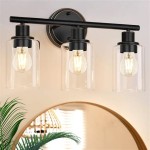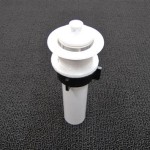Replacing A Bathroom Vent Fan: A Comprehensive Guide
Bathroom vent fans are crucial for maintaining air quality and preventing moisture buildup, which can lead to mold growth, mildew, and structural damage. Over time, these fans can become noisy, inefficient, or even stop working altogether. Replacing a bathroom vent fan is a manageable DIY project for many homeowners, but it requires careful planning, the right tools, and a thorough understanding of the process. This article provides a detailed guide to replacing a bathroom vent fan, covering preparation, removal, installation, and post-installation checks.
Assessing the Situation and Selecting a Replacement Fan
Before embarking on the replacement process, a thorough assessment of the existing fan and the bathroom's ventilation needs is essential. This assessment informs the selection of a suitable replacement fan and ensures a successful installation.
The first step involves determining the existing fan's size and performance. This information is typically found on a label located on the fan housing, often expressed in cubic feet per minute (CFM). The CFM rating indicates the volume of air the fan can move per minute. A common rule of thumb is to have at least 1 CFM per square foot of bathroom area. For example, a 50-square-foot bathroom should have a fan with a CFM rating of at least 50. Factors such as ceiling height, frequency of shower use, and the number of occupants can also influence the required CFM rating. Bathrooms with higher ceilings or frequent showers might benefit from a fan with a higher CFM rating.
Next, consider the noise level of the replacement fan. Fan noise is measured in sones, with lower sone ratings indicating quieter operation. A rating of 1.0 sone or less is generally considered quiet, while ratings above 4.0 sones can be quite noisy. If the bathroom is located near bedrooms or living areas, a quieter fan may be preferable.
Beyond CFM and sone ratings, other features to consider include built-in lights, humidity sensors, and timers. Fans with built-in lights provide added illumination, while humidity sensors automatically activate the fan when moisture levels rise, preventing the formation of mold and mildew. Timers allow the fan to run for a set period after the bathroom is used, ensuring thorough ventilation.
Finally, ensure the replacement fan is compatible with the existing wiring and ductwork. Check the voltage requirements of the new fan and confirm that the existing wiring can handle the load. Also, measure the diameter of the existing ductwork and select a fan with a compatible duct connector. If the existing ductwork is undersized or damaged, it may need to be replaced as well.
Preparing for the Replacement Process
Proper preparation is crucial for a safe and efficient fan replacement. This involves gathering the necessary tools and materials, disconnecting power to the circuit, and protecting the surrounding area.
The following tools and materials are typically required for a bathroom vent fan replacement: a new vent fan, a screwdriver (both Phillips head and flathead), wire cutters, wire strippers, wire connectors, a voltage tester, a drill (optional, for minor adjustments), safety glasses, work gloves, a ladder or step stool, duct tape or foil tape, and a utility knife.
Safety is paramount when working with electrical systems. Before starting any work, it is essential to disconnect power to the bathroom circuit breaker. Locate the circuit breaker that controls the bathroom fan and switch it to the "off" position. To verify that the power is indeed off, use a voltage tester to check the wires connected to the existing fan. Never assume the power is off without confirming it with a voltage tester.
Protecting the surrounding area is also important. Spread a drop cloth over the floor to catch any debris that may fall during the removal and installation process. Wear safety glasses to protect your eyes from dust and debris. Work gloves will protect your hands from sharp edges and electrical shock.
Once the power is disconnected and the area is protected, carefully inspect the existing fan installation. Note the location of the wiring connections and the ductwork connection. Take photographs or draw a diagram to help you remember how everything is connected. This will be particularly helpful during the installation process.
Removing the Existing Vent Fan
Removing the existing vent fan involves disconnecting the wiring, detaching the ductwork, and removing the fan housing from the ceiling. This process should be performed carefully to avoid damaging the surrounding ceiling or wiring.
Begin by removing the fan cover. Most fan covers are held in place by spring clips or screws. Gently pull down on the cover or unscrew the screws to release it. Once the cover is removed, you will have access to the fan motor, wiring, and ductwork.
Next, disconnect the wiring. Using wire cutters, carefully cut the wires connected to the fan motor. Make sure to leave enough wire length to reconnect to the new fan. Use wire strippers to strip the insulation from the ends of the wires. Cap the exposed wires with wire connectors to prevent accidental contact.
After disconnecting the wiring, detach the ductwork from the fan housing. The ductwork is typically connected to the fan housing with duct tape or a clamp. Use a utility knife to cut the duct tape or loosen the clamp. Carefully remove the ductwork from the fan housing.
Finally, remove the fan housing from the ceiling. The fan housing is usually attached to the ceiling joists with screws or nails. Use a screwdriver or drill to remove the screws or nails. In some cases, the fan housing may be secured with brackets or straps. Carefully detach the brackets or straps before removing the fan housing. If the fan housing is difficult to remove, carefully pry it loose with a flathead screwdriver.
Once the fan housing is removed, inspect the opening in the ceiling. Clean any dust or debris from the opening. If necessary, make minor adjustments to the opening to accommodate the new fan housing.
Installing the New Vent Fan
Installing the new vent fan involves mounting the fan housing, connecting the ductwork, and wiring the fan to the electrical circuit. This process should be performed according to the manufacturer's instructions.
Start by mounting the new fan housing in the ceiling opening. Most new fans come with mounting brackets that can be adjusted to fit different ceiling joist spacings. Secure the fan housing to the ceiling joists with screws or nails. Make sure the fan housing is level and securely attached to the ceiling.
Next, connect the ductwork to the fan housing. Align the ductwork with the duct connector on the fan housing. Secure the ductwork to the fan housing with duct tape or foil tape. Ensure the connection is airtight to prevent air leakage. Foil tape is generally preferred over duct tape as it is more durable and resistant to moisture.
After connecting the ductwork, wire the fan to the electrical circuit. Connect the wires from the fan to the corresponding wires in the ceiling. Use wire connectors to secure the connections. Ensure the connections are tight and secure. Typically, there will be a black (hot) wire, a white (neutral) wire, and a green (ground) wire. Match the wire colors carefully to avoid electrical problems. Refer to the manufacturer's instructions for specific wiring diagrams.
Once the wiring is complete, carefully tuck the wires into the fan housing. Make sure the wires are not pinched or damaged. Replace the fan cover. Secure the cover with the spring clips or screws. Ensure the cover is securely attached to the fan housing.
Post-Installation Checks and Testing
After installing the new vent fan, it is important to perform post-installation checks and testing to ensure it is working properly. This includes verifying the fan's operation, checking for air leaks, and ensuring proper ventilation.
First, restore power to the bathroom circuit breaker. Switch the circuit breaker to the "on" position. Turn on the fan switch to test the fan's operation. Verify that the fan motor is running smoothly and quietly. Check for any unusual noises or vibrations. If the fan does not turn on, double-check the wiring connections and the circuit breaker.
Next, check for air leaks around the fan housing and ductwork connections. Use your hand to feel for any air escaping from the connections. If you detect any air leaks, seal them with duct tape or foil tape. Air leaks can reduce the fan's efficiency and increase energy consumption.
Finally, assess the bathroom's ventilation. Turn on the shower and run hot water for several minutes. Observe how quickly the fan removes the moisture from the air. If the fan is working properly, the mirrors and walls should remain relatively clear of condensation. If the bathroom is still damp after several minutes, the fan may not be powerful enough or the ductwork may be obstructed.
If any issues are identified during the post-installation checks, address them promptly. This may involve adjusting the wiring connections, sealing air leaks, or replacing the fan with a more powerful model. Proper installation and testing will ensure the new bathroom vent fan provides effective ventilation and helps prevent moisture-related problems.

Install A New Bathroom Vent Fan Light The San Fernando Valley Sun

How To Replace And Install A Bathroom Exhaust Fan From Start Finish For Beginners Easy Diy

How To Change Bathroom Exhaust Fan Easy

How To Install A Bathroom Exhaust Fan Ducting Full Walkthrough Broan 688 Builds By Maz

How To Install A Bathroom Exhaust Fan Broan 688

How To Replace A Noisy Or Broken Bathroom Vent Exhaust Fan

How To Replace And Install Broken Bathroom Exhaust Fan Motor Easy Diy Fix Noisy Rattling

Blog

How To Install Clean A Bathroom Fan

How To Replace Or Install An Easy Bath Fan The Home







